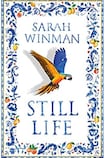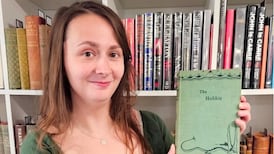
In the small hours of November 5th, 1966, the river Arno burst its banks and flooded Florence. The Renaissance city was devastated by some 600,000 tonnes of mud that remained in its wake. Fifty thousand Florentine families lost their homes. Thousands of masterpieces of art and and rare books were damaged or destroyed as galleries, churches and museums sat submerged in mud that is reported to have reached 6.8m (22ft) in height in some parts of the city.
In the immediate aftermath, hundreds of young people travelled from across the Continent to help with the great clean-up, rescuing priceless paintings from the Uffizi galleries and providing aid to the broken-hearted Florentines. These spontaneous volunteers became known as the angeli del fango – the mud angels.
This is the world of Sarah Winman’s fourth novel, in which the beauty of art collides with the random tragedies of life and is not always victorious. And yet the response – how people choose to persevere, to drag each other through – somehow makes the suffering worthwhile.
From the award-winning author of When God Was a Rabbit and Tin Man, Still Life intercepts a young British soldier, Ulysses Temper, with Evelyn Skinner, a gay sexagenarian art historian and possible spy. It is 1944 and they are hiding in the ruined cellar of a Tuscan villa as bombs fall. Evelyn has come to Italy to salvage paintings from the wreckage of war and reminisce about the time she encountered EM Forster as she fell in love with a Florentine maid.
Ulysses is utterly changed by their encounter – the seeds she plants in his mind about truth and beauty take root and ultimately grow into a worldview that will alter the trajectory of his life, and those around him, for the ensuing four decades we spend in his company.
Transversing across that pivotal time in European history and moving from the dirty smog of London’s East End to the sensuous piazzas of Florence, Winman’s ability to deliver a micro story on a macro scale is impressive. There is something very particular about the prose that sets her apart from other contemporary novelists. The omniscient narrator of Still Life bears more resemblance to that of a classic novel than might be currently considered fashionable – the tone is warm and avoids the chilly vernacular of many of her peers – and Winmanis unafraid to infuse the prose with moments of magical realism via a sentient tree here, a cognisant parrot there.
The novel presupposes that magic is all around us – perhaps we just call it other things, superstition, coincidence, serendipity, instinct, luck. And it offers a rich education in art appreciation and social history. All of which, when delivered with the author’s technical wizardry, elevates the work as one that will resonate long after this particular moment in time. It is timeless, not trendy; proactive, not reactive.
At the centre of the novel is a question – what is the heart capable of? Ulysses suggests an answer: “grace and fury”. Throughout the narrative, the complex, compelling characters are constantly pushing their hearts to the absolute limit of endurance.
Her previous novels have shown Winman as one of the greatest chroniclers of grief – the great cost of love – and of the ghosts that haunt our lives – regret, missed opportunities, lost connections. In Still Life, she emerges now as the great narrator of hope. When all feels lost, the love and kindness of others can revive us. Winman is unafraid to chart this sentiment but never slips into sentimentality. There is a constant friction in the text between the “conspiracy of beauty everywhere” and “the acknowledgement that if such beauty exists then so does the opposite”. A beautiful life is not a perfect one, with an absence of grief, but a full one that is worthy of grieving.
Pete, the gifted piano player in Winman’s supporting cast, writes a song about the mud angels. It is a ballad, “about good rising out of need, about love in all its forms, about kindness and looking out for one another, and only the third verse was about art, but even that was about the paradox of meaning. It was classic Pete. Took you one way, took you back, and then delivered the punch.”
His lyrics serve as the perfect description of Winman’s novel, a celebration of “art and life intwined” that delivers to us solace, hope and the courage to dream again. We must save art, because in the end, it is the art that will save us. Classic Winman.












